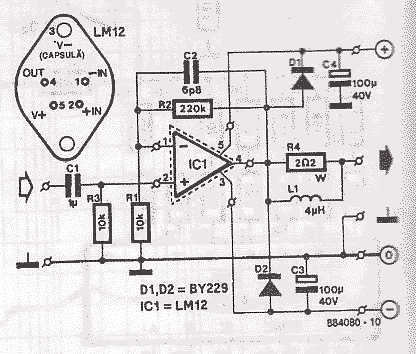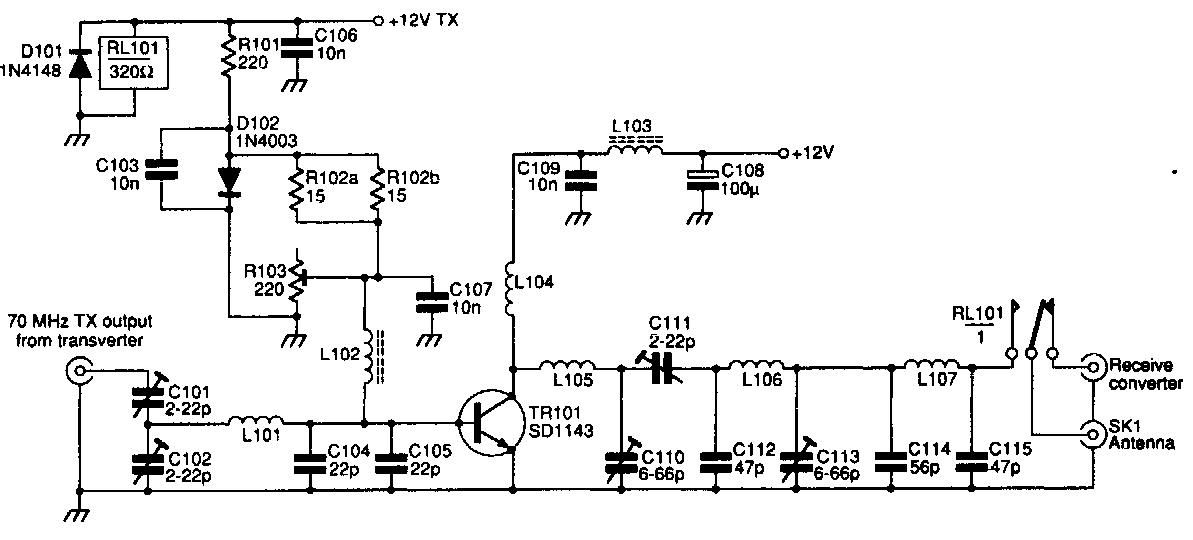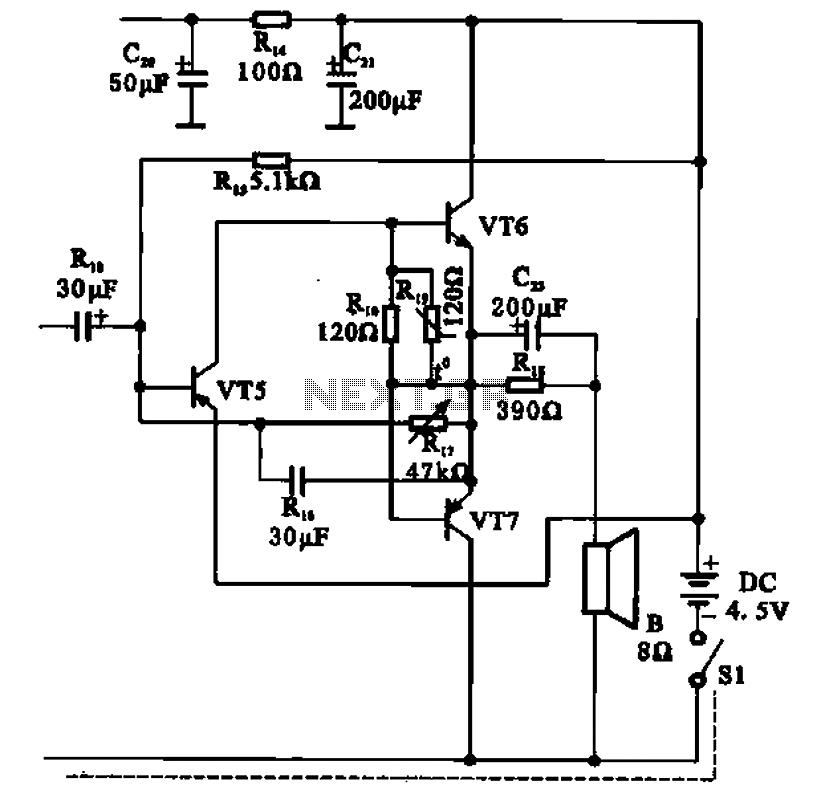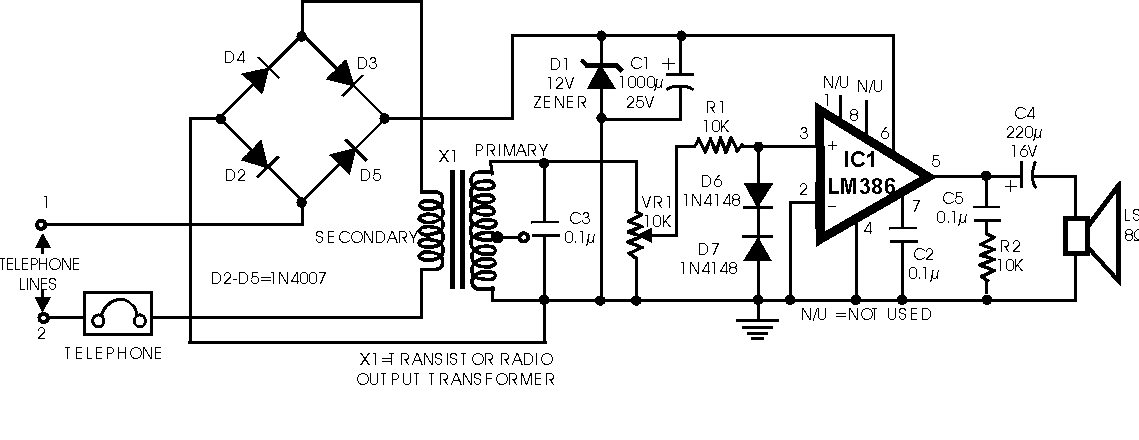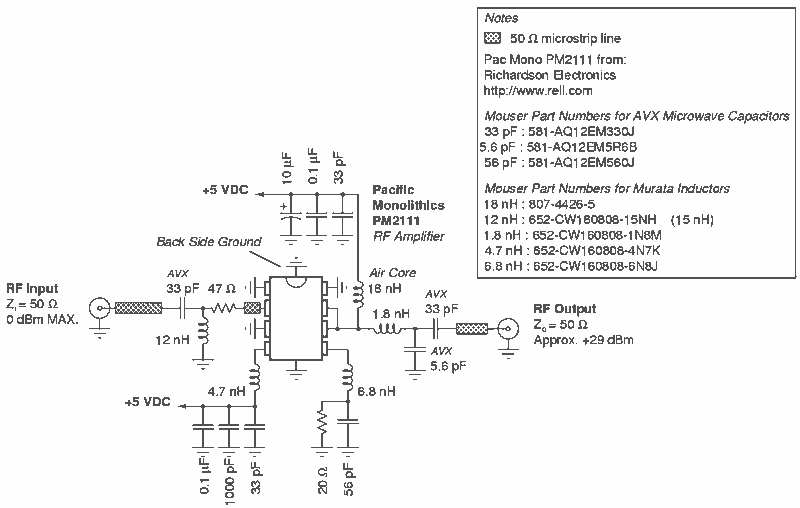
Motional feed back amplifier
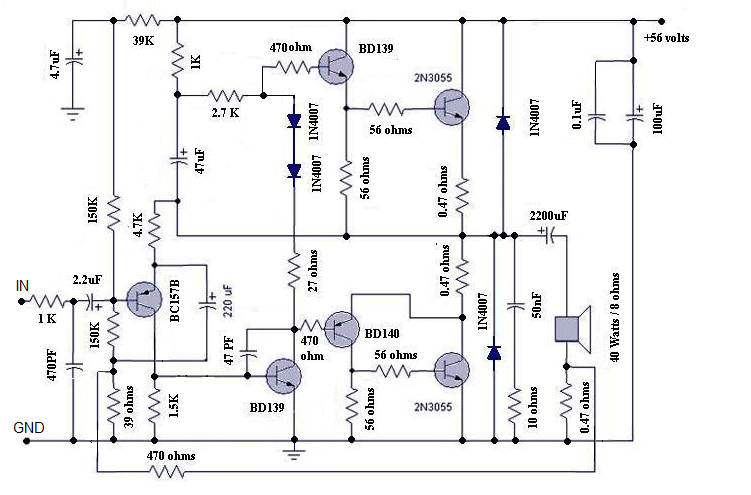
This versatile amplifier circuit was designed and submitted by Mr. Seetharaman Subramanian from Chennai. The original concept appeared in Practical Electronics, a UK-based magazine, and the circuit was finalized after extensive field trials and modifications between 1981 and 1986. Many amplifiers have been assembled based on this design, which continues to be used in various settings. The circuit is known for its crystal-clear bass response, mid, and high frequencies, along with good transient response and low distortion. It is widely recognized that dynamic loudspeakers exhibit significant nonlinearity, generating more distortion than other system components, particularly at low frequencies. When cone motion is sensed and fed back to the amplifier's earlier stage, distortion can be significantly reduced. Motional Feedback (MFB) was a speaker system developed by Philips in the early 1970s, which introduced a feedback system that improved low-frequency response in compact enclosures. This amplifier design utilizes a novel approach where the current flow through the voice coil, which is proportional to cone movement, serves as feedback. The amplifier is based on a standard Philips audio application circuit, delivering 40 Watts RMS at less than 0.06% Total Harmonic Distortion into an 8-ohm speaker, with a frequency response from 20 Hz to 100 kHz. It features a conventional Class B directly coupled quasi-complementary output stage powered by a single 56-volt supply. The circuit includes a BC157 pre-driver, a BD139 driver, and a complementary pair output driver stage using BD139 and BD140, with a 2N3055 as the final output stage. The speaker voice coil current is sensed through a 0.47-ohm resistor connected from one end of the speaker to ground, and this signal is fed back negatively to the previous stage through a 470-ohm resistor. The half supply at the speaker coupling capacitor can be adjusted by varying a 39K resistor, and the quiescent current through the output transistors can be fine-tuned with a 22-ohm resistor in series with two 1N4007 bias diodes.
This amplifier circuit employs a feedback mechanism that utilizes the current flowing through the speaker's voice coil to enhance audio fidelity. By achieving a more accurate representation of the cone's movement, the circuit effectively reduces distortion that typically arises from the nonlinearity of dynamic loudspeakers, especially at low frequencies where the cone excursions are significant. The design's reliance on a single power supply simplifies the implementation, making it suitable for various audio applications without the need for complex power management.
The Class B output stage configuration allows for efficient operation, with the 2N3055 transistor providing the necessary power amplification. The inclusion of a pre-driver and driver stage ensures that the signal is adequately amplified before reaching the output stage, maintaining clarity and reducing the risk of distortion. The feedback loop, utilizing a 0.47-ohm resistor, plays a crucial role in monitoring the speaker's performance, allowing for real-time adjustments to the amplifier's output based on the speaker's behavior.
The adjustable half supply at the speaker coupling capacitor provides flexibility in tuning the amplifier's response, enabling the user to optimize performance for different speaker configurations. Additionally, the capability to adjust the quiescent current through the output transistors allows for precise control over the amplifier's thermal performance and efficiency, ensuring reliable operation over extended periods.
Overall, this amplifier circuit represents an innovative approach to audio amplification, combining established principles of feedback with modern design practices to deliver high-quality sound reproduction. Its versatility and adaptability make it suitable for a wide range of audio systems, from home theaters to professional audio setups.This versatile amplifier circuit is designed and submitted by Mr Seetharaman Subramanian from Chennai. The full credit of this article goes to him and we are very proud to publish this fabulous circuit here.
This concept has appeared long back in Practical Electronics a UK based Magazine. Based on this concept I designed this circuit during 1981 to 1986 with lots of field trials and modifications, the design was frozen in 1986. I have assembled so many amplifiers for me and for my friends based on this design with various power levels. They are still kicking in so many houses. This concept can be applied to any existing amplifier also. You must listen to believe the crystal clear thumping bass response. crystal clear mid and hi frequencies. Good transient response with very low distortion. Hope you guys will enjoy the reproduction of this amplifier. In the art of audio sound reproduction it is well-known that the dynamic loudspeaker is more nonlinear and generates more distortion than all the other system components combined.
This is particularly true at low frequencies which require large cone excursions where the stiffness of both the inner spider and the outer surround increases rapidly as the cone approaches its peak displacement, resulting in a nonlinear suspension compliance generating high distortion. For example, in a typical high fidelity sound system at a frequency of about 35 Hz the total harmonic distortion of the amplifier might be of the order of 0.
01%, whereas the distortion of the loudspeaker might range from about 3. 0% to about 50. 0%, depending upon the loudness. If this cone motion can be sensed and given as a feed back to the earlier stage of the amplifier, this distortion can be reduced dramatically. Motional Feedback (MFB) was a speaker system developed in the early 1970s by Philips Holland. It introduced a feedback system to the woofers of HiFi loudspeakers, enabling them to achieve a more extended low frequency response in a relatively small enclosure.
The key benefits are a very controlled bass response. Any distortion induced by the enclosure or the woofer itself is immediately corrected by the feedback. These hand-built speakers were sounding very good and were quite expensive. As a different approach, instead of using the cone movement, the current flow through the voice can be sensed (the current is proportional to cone movement) and can be used as a cone movement feedback.
This novel idea is used in this amplifier design (I don`t claim any originality; this idea has appeared in Practical Electronics UK Magazine long back They might have even patented it). The amplifier used here is a standard Philips audio application circuit, with a specification of 40 Watt RMS @ < 0.
06% Total Harmonic Distortion into 8 ohms impedance speaker and having a frequency response from 20Hz to 100 KHz, suitably modified for our application. The amplifier is a conventional class B directly coupled quasi complimentary out put stage, operating with single 56Volt supply (no need for a regulated or dual power supply).
BC157 is the pre-driver and half supply stabilizer. BD 139 is the driver, a BD139 and a BD140 complimentary pair out put driver stage with 2N3055 as final out put stage. The speaker voice coil current is sensed through 0. 47 ohms resistance connected from speaker one end to ground. This signal is given as negative fed back to previous stage through 470 ohms. The half supply at speaker coupling capacitor can be adjusted by varying the 39K resistance (if required you may fix a 100K pre set in the place of 39K and adjust for half supply with no in put signal at junction of both 0.
47 ohms of out put transistors and speaker coupling capacitor). The quiescent current through output transistors can be adjusted with 22 ohms in series with two bias diodes 1N4007. The value for 50mA quiescent current will lie between 15 to 33 ohms for a supply of 56volts 🔗 External reference
This amplifier circuit employs a feedback mechanism that utilizes the current flowing through the speaker's voice coil to enhance audio fidelity. By achieving a more accurate representation of the cone's movement, the circuit effectively reduces distortion that typically arises from the nonlinearity of dynamic loudspeakers, especially at low frequencies where the cone excursions are significant. The design's reliance on a single power supply simplifies the implementation, making it suitable for various audio applications without the need for complex power management.
The Class B output stage configuration allows for efficient operation, with the 2N3055 transistor providing the necessary power amplification. The inclusion of a pre-driver and driver stage ensures that the signal is adequately amplified before reaching the output stage, maintaining clarity and reducing the risk of distortion. The feedback loop, utilizing a 0.47-ohm resistor, plays a crucial role in monitoring the speaker's performance, allowing for real-time adjustments to the amplifier's output based on the speaker's behavior.
The adjustable half supply at the speaker coupling capacitor provides flexibility in tuning the amplifier's response, enabling the user to optimize performance for different speaker configurations. Additionally, the capability to adjust the quiescent current through the output transistors allows for precise control over the amplifier's thermal performance and efficiency, ensuring reliable operation over extended periods.
Overall, this amplifier circuit represents an innovative approach to audio amplification, combining established principles of feedback with modern design practices to deliver high-quality sound reproduction. Its versatility and adaptability make it suitable for a wide range of audio systems, from home theaters to professional audio setups.This versatile amplifier circuit is designed and submitted by Mr Seetharaman Subramanian from Chennai. The full credit of this article goes to him and we are very proud to publish this fabulous circuit here.
This concept has appeared long back in Practical Electronics a UK based Magazine. Based on this concept I designed this circuit during 1981 to 1986 with lots of field trials and modifications, the design was frozen in 1986. I have assembled so many amplifiers for me and for my friends based on this design with various power levels. They are still kicking in so many houses. This concept can be applied to any existing amplifier also. You must listen to believe the crystal clear thumping bass response. crystal clear mid and hi frequencies. Good transient response with very low distortion. Hope you guys will enjoy the reproduction of this amplifier. In the art of audio sound reproduction it is well-known that the dynamic loudspeaker is more nonlinear and generates more distortion than all the other system components combined.
This is particularly true at low frequencies which require large cone excursions where the stiffness of both the inner spider and the outer surround increases rapidly as the cone approaches its peak displacement, resulting in a nonlinear suspension compliance generating high distortion. For example, in a typical high fidelity sound system at a frequency of about 35 Hz the total harmonic distortion of the amplifier might be of the order of 0.
01%, whereas the distortion of the loudspeaker might range from about 3. 0% to about 50. 0%, depending upon the loudness. If this cone motion can be sensed and given as a feed back to the earlier stage of the amplifier, this distortion can be reduced dramatically. Motional Feedback (MFB) was a speaker system developed in the early 1970s by Philips Holland. It introduced a feedback system to the woofers of HiFi loudspeakers, enabling them to achieve a more extended low frequency response in a relatively small enclosure.
The key benefits are a very controlled bass response. Any distortion induced by the enclosure or the woofer itself is immediately corrected by the feedback. These hand-built speakers were sounding very good and were quite expensive. As a different approach, instead of using the cone movement, the current flow through the voice can be sensed (the current is proportional to cone movement) and can be used as a cone movement feedback.
This novel idea is used in this amplifier design (I don`t claim any originality; this idea has appeared in Practical Electronics UK Magazine long back They might have even patented it). The amplifier used here is a standard Philips audio application circuit, with a specification of 40 Watt RMS @ < 0.
06% Total Harmonic Distortion into 8 ohms impedance speaker and having a frequency response from 20Hz to 100 KHz, suitably modified for our application. The amplifier is a conventional class B directly coupled quasi complimentary out put stage, operating with single 56Volt supply (no need for a regulated or dual power supply).
BC157 is the pre-driver and half supply stabilizer. BD 139 is the driver, a BD139 and a BD140 complimentary pair out put driver stage with 2N3055 as final out put stage. The speaker voice coil current is sensed through 0. 47 ohms resistance connected from speaker one end to ground. This signal is given as negative fed back to previous stage through 470 ohms. The half supply at speaker coupling capacitor can be adjusted by varying the 39K resistance (if required you may fix a 100K pre set in the place of 39K and adjust for half supply with no in put signal at junction of both 0.
47 ohms of out put transistors and speaker coupling capacitor). The quiescent current through output transistors can be adjusted with 22 ohms in series with two bias diodes 1N4007. The value for 50mA quiescent current will lie between 15 to 33 ohms for a supply of 56volts 🔗 External reference
